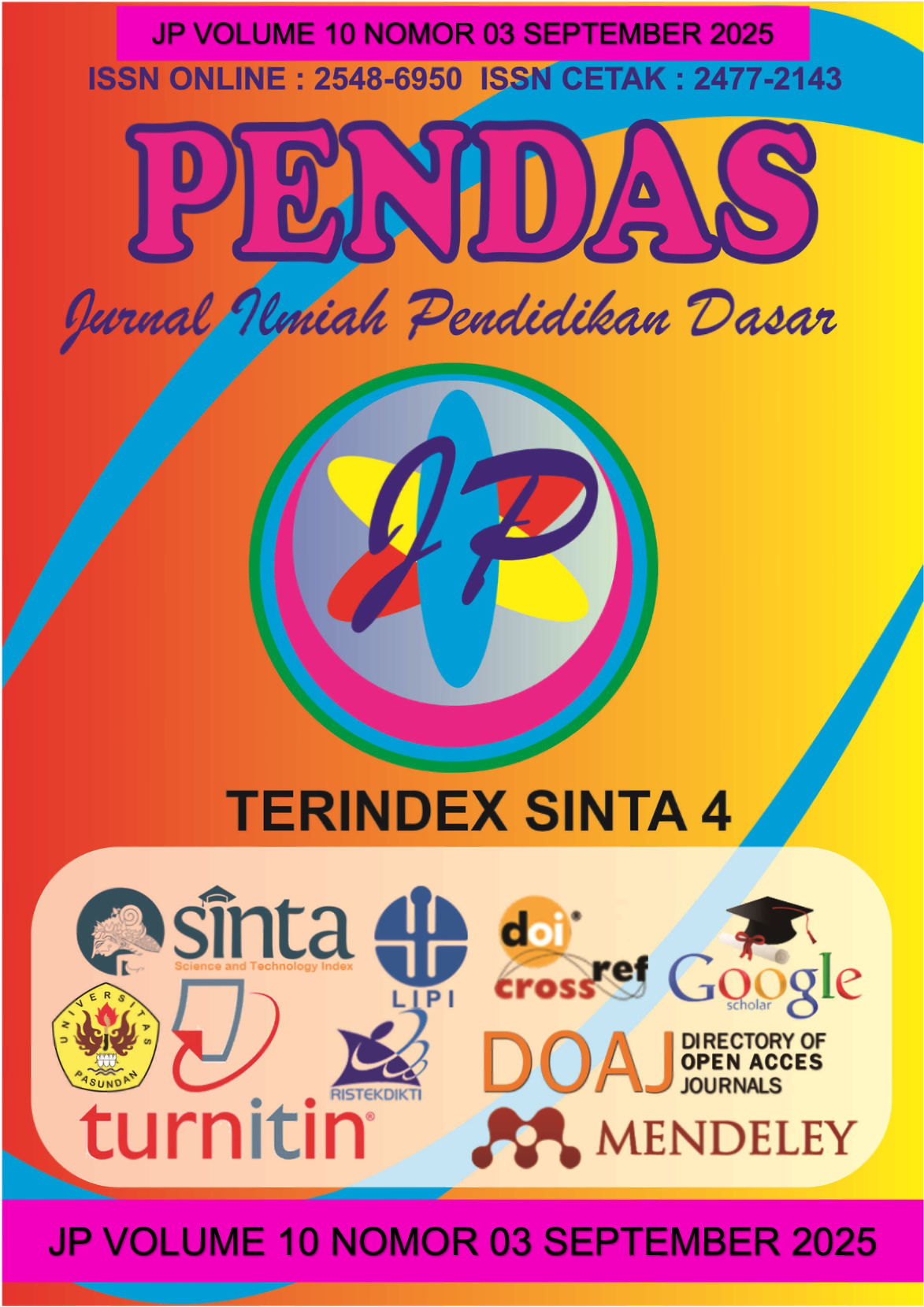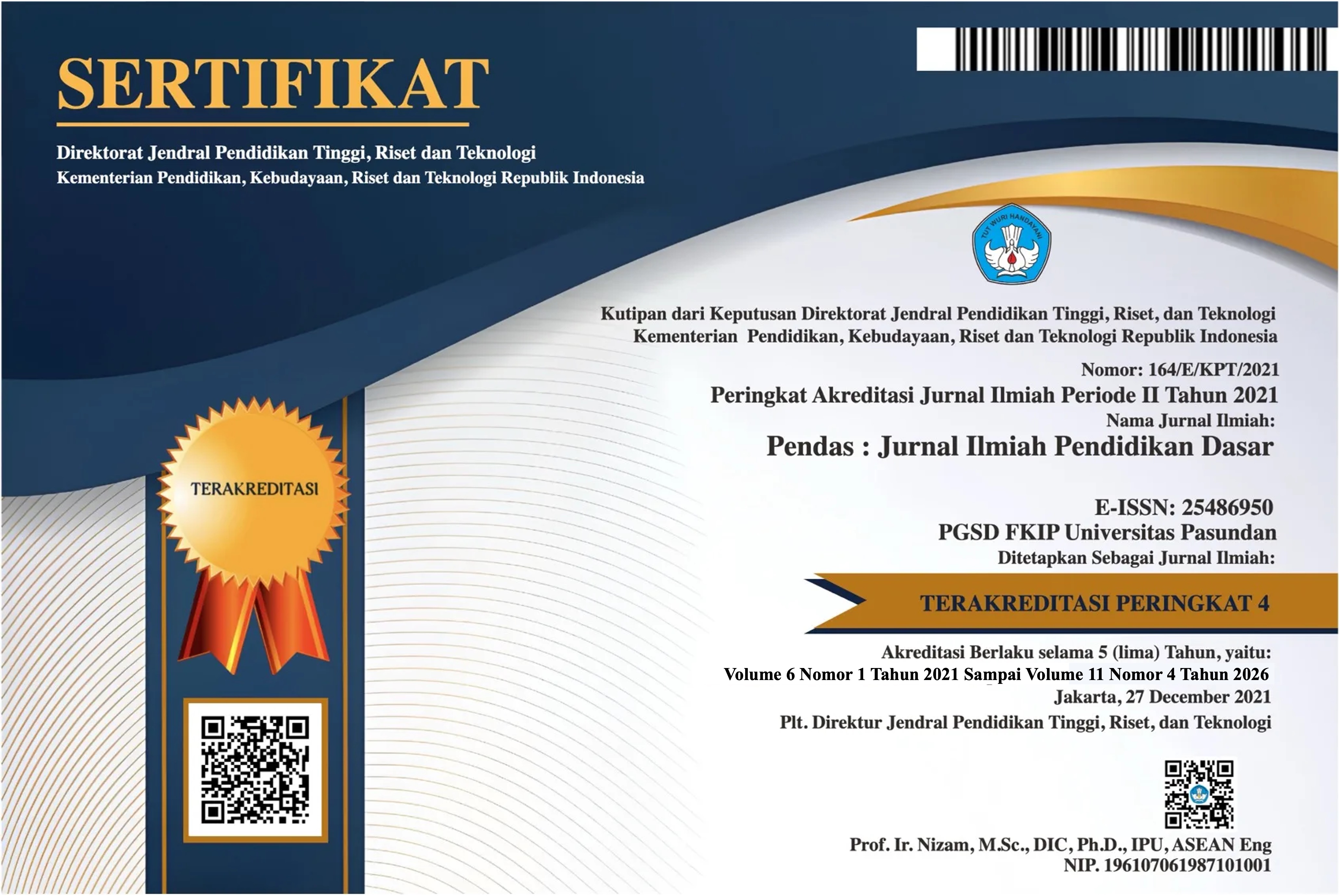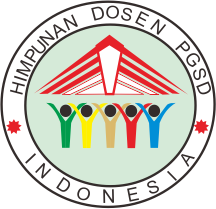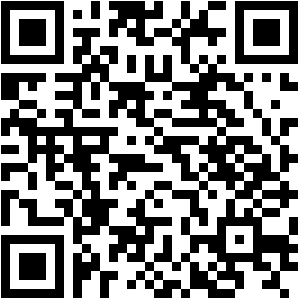THE EFFECTIVENESS OF E-STORY TO ENHANCE READING ALOUD FOR STUDENTS OF IMMANUEL 2 ELEMENTARY SCHOOL
DOI:
https://doi.org/10.23969/jp.v10i03.33465Keywords:
E-Story, Reading Aloud, Scaffolded technique, Pre-Experimental ResearchAbstract
This research aims to determine whether the use of digital media in the form of E-stories affects the reading aloud skills of fifth-grade students at Immanuel 2 Elementary School. The research employed a quantitative method using a pre-experimental design with one group pre-test and post-test. The sample consisted of 35 fifth-grade students. The instruments used in this study was reading aloud test. During the treatment, students participated in two scaffolded E-story sessions involving digital storytelling, guided reading, and group practice using selected sentences containing target keywords. The data analysis revealed a t-value of 28.25 and an effect size of 0.087 for the effectiveness test, indicating a very strong effect. indicating a significant difference between students’ reading performance before and after the treatment. It can be concluded that the use of E-story is effective for students’ reading aloud. Therefore, E-stories can serve as an effective alternative to enhance reading aloud elementary school students.
Downloads
References
Abidin, M. J. Z., et al. (2018). Literacy in the 21st century: A comprehensive guide. Publisher.
Ansya, Y. A., Alfianita, A., & Syahkira, H. P. (2024). Optimizing Mathematics Learning in Fifth Grades: The Critical Role of Evaluation in Improving Student Achievement and Character. Progres Pendidikan, 5(3), 302–311. https://prospek.unram.ac.id/index.php/PROSPEK/article/view/1120
Bayu, A. P. (2017). Reading Activities. Jurnal Pembelajaran Prospektif, 4(1).
Baker, A., & Goldstein, S. (2010). Pronunciation Pairs: An Introduction to the Sounds of English. Cambridge University Press.
Beck, I. L., & McKeown, M. G. (2013). Bringing words to life: Robust vocabulary instruction (2nd ed.). Guilford Press.
Beck, I. L., & McKeown, M. G. (2013). Listening to children read aloud: A guide for teachers. International Reading Association.
Blaz, D. (2022). The World Language Teacher’s Guide to Active Learning: Strategies and Activities for Increasing Student Engagement. In The World Language Teacher’s Guide to Active Learning: Strategies and Activities for Increasing Student Engagement. https://doi.org/10.4324/9781003293262
Branco, J., & Associação Mais Cidadania. (2016). Digital storytelling: A guide for educators.
Bredekamp, S., Copple, C., & Neuman, S. B. (2000). Learning to read and write: Developmentally appropriate practices for young children. National Association for the Education of Young Children (NAEYC).
Brown, B. L., & Dotson, K. (2004). The impact of e-books on children’s literacy development. Journal of Educational Technology, 10(2), 23-30.
Cantika, P. Z., Batau, H. St., & Muliati. M. (2023). Improving Students’ Literacy Reading Skill Using E-Book System on the Twelfth Grade at SMA Bosowa School Makassar. https://doi.org/10.52208/aellj.v8i2.1065
Campbell, J. (2018). Exploring the role of digital narratives in enhancing student engagement and learning outcomes. Journal of Interactive Learning Research, 29(4), 567-579.
Celce-Murcia, M., Brinton, D. M., & Goodwin, J. (2010). Teaching Pronunciation: A Reference for Teachers of English to Speakers of Other Languages.
Cohen, L., Manion, L., & Morrison, K. (2017). Research methods in education (8th ed.). Routledge.
Creswell, J. W. (2018). Research design: Qualitative, quantitative, and mixed methods approaches (5th ed.). Sage Publications.
Darnis, S. (2020). The Development of Children’s Story Book Media Based on Oral Story of Local Tradition to Support the Literacy Program for Kindergarten Level. As-Sibyan: Jurnal Pendidikan Anak Usia Dini, 5(1). https://doi.org/10.32678/as-sibyan.v5i1.2472
Delamain, C., & Spring, J. (2018). Reading between the lines set two: Inference skills for children aged 8 - 12. In Reading Between the Lines Set Two: Inference skills for children aged 8 - 12. https://doi.org/10.4324/9781315098500
Dewey, J. (1938). Experience and education. Macmillan.
Dikdasmen. (2022). Kurikulum Merdeka: Pedoman implementasi. Kementerian Pendidikan, Riset, dan Teknologi Republik Indonesia.
Field, A. (2013). Discovering statistics using IBM SPSS statistics (4th ed.). Sage Publications.
Firmansyah, H. (2023). Pemanfaatan Literasi Digital dalam Pembelajaran. https://doi.org/10.31004/jpdk.v5i2.12511
Fisher, D., & Frey, N. (2014). Improving adolescent literacy: Strategies at work. Pearson.
Garcia, A. (2012). Good Reception: Utilizing Mobile Media and Games to Develop Critical Inner-City Agents of Social Change. In Good Reception.
Gee, J. P. (2015). Literacy and education. Routledge.
Gibbons, P. (2002). Scaffolding language, scaffolding learning: Supporting English language learners in the classroom. Heinemann.
Grant, M. C., Fisher, D., & Lapp, D. (2018). Reading and Writing in Science: Tools to Develop Disciplinary Literacy. In Reading and Writing in Science: Tools to Develop Disciplinary Literacy. https://doi.org/10.4135/9781483393322
Greenfield, S. (2015). Mind change: How digital technologies are leaving their mark on our brains. Random House.
Harmer, J. (2015). The Practice of English Language Teaching (5th ed.). Pearson.
Harris, J. (2012). Digital storytelling with young children. Routledge.
Higgin, J., & Hess, K. (1999). Interactive storytelling: A tool for teaching reading. Reading Horizons, 39(1), 45-58.
Hughes, A., & Taylor, N. (2009). Teaching English to Young Learners: Fifth International TEYL Research Seminar 2008-9 Papers. Teaching English To Young Learners: Fifth International TEYL Research Seminar 2008-9 Papers.
Jeoung. (2010). A Comparison of the Influence of Electronic Books and Paper Books on Reading Comprehension, Eye Fatigue, and Perception. Retrieved from www.emeraldinsight.com
Jong, M. T., & Bus, A. G. (2003). The efficacy of electronic books in fostering young children's literacy development. Journal of Educational Psychology, 95(3), 685-692.
Jones, Troy and Brown Carol. (2011). Reading engagement: a comparison between e-books and traditional print books in an elementary classroom. International journal of instruction.
Kamil, M. L., David Pearson, P., Moje, E. B., & Afflerbach, P. P. (2011). Handbook of Reading Research: Volume IV. InHandbook of Reading Research: Volume IV (Vol. 4). https://doi.org/10.4324/9780203840412
Khofshoh, Z. A., & Arifin, Moch. (2021). Improving Student’s Reading Comprehension Through English Short Story at Eleventh Grade of SMAS NU Centini Laren Lamongan. PROJECT (Professional Journal of English Education), 4(2). https://doi.org/10.22460/project.v4i2.p311-323
Lee, J. (2016). Digital storytelling: A narrative-based approach to teaching and learning. Educational Technology, 56(4), 26-30.
Lewis, D. (2015). The brain and the digital age: How technology affects our minds. Psychology Press.
Luis, C. L. (2020). Role of Short Stories in EFL Classes. Journal of English Language Teaching and Applied Linguistics, 2(5). https://doi.org/10.32996/jeltal.2020.2.5.2
Maibodi, A. (2008). Learning English through short stories. Iranian Journal of Language Studies, 2(1).
Mardhiyah, N., et al. (2021). Cultural and citizenship literacy in the 21st century education. Publisher.
Masitowarni Siregar, Baharuddin, Endang Matulissa, Nelly Marlina Tampubolon Lili Sartika, & Dimas Hendrawan. (2021). The Implementation of the Reading to Learn Strategies in the Teaching of Short Stories Reading Compehension Achievement at SMPN 3 Medan. LingLit Journal Scientific Journal for Linguistics and Literature, 2(4). https://doi.org/10.33258/linglit.v2i4.559
Mayer, R. E. (2009). Multimedia learning. Cambridge University Press.
McNair, B. J. (2006). E-stories: The future of storytelling in a digital age.
Moody. 2010. Using electronic books in the classroom to enhance emergent literacy skills in young children. Journal of literacy and technology.Volume 11, No.11.
Murray, J. (2019). The Art of Digital Storytelling: Creating Engaging E-Stories. Routledge.
Murray, J. H. (1997). Hamlet on the holodeck: The future of narrative in cyberspace. The Free Press.
Nanang Apriyanto, I. (2017). Improving Students’ Reading Skill by Using Short Story at Eight Grade of Smpn 4 Bandar Pacitan in 2016/2017 Academic Year. Ekp, 13(3).
Nasution, S., Zulkarnain, M., & Suhariyanti, S. (2020). An Application of Choral Reading Strategy in English Language Lessons in Economic Text to Increasing Reading Skills for The Student Grade Xi State Vocational School 2 Medan. Dharmawangsa: International Journal of the Social Sciences, Education and Humanitis, 1(3). https://doi.org/10.46576/ijsseh.v1i3.817
Novasyari, R. (2019). Significant Roles of Children's Literature in Efl. Global Expert: Jurnal Bahasa Dan Sastra, 8(1). https://doi.org/10.36982/jge.v8i1.798
Novitasari, D., Janah, E. F., & Chamdani, M. (2019). A Short Story Reading Section as an Alternative Way to Improve Student’s Literacy in Sd N 6 Panjer Kebumen. Social, Humanities, and Educational Studies (SHEs): Conference Series, 1(2). https://doi.org/10.20961/shes.v1i2.26806
Ofra, S. (2008). Understanding narrative comprehension in digital storytelling. Literacy Research and Instruction, 47(3), 209-225.
Pandiangan, R. (2020). Integrasi teknologi dalam pembelajaran: Penggunaan e-stories untuk meningkatkan keterlibatan siswa. Jurnal Pendidikan dan Teknologi, 5(2), 123-134.
Parmawati, A., & Yugafiati, R. (2017). Using Authentic Material to Improve Students’ Reading Interest (A Classroom Action Research in the Second Semester Students of STKIP Siliwangi Bandung). ELTIN JOURNAL, Journal of English Language Teaching in Indonesia, 5(1). https://doi.org/10.22460/eltin.v5i1.p1-8
Poejilestari, N. (2019). Improving The Students’ Reading Skill Through Short Story Technique. Journal of English Language and Literature (JELL), 4(02). https://doi.org/10.37110/jell.v4i02.79
Pratiwi, D. I., Putri, J., & Suhadi, A. (2020). Short Story as a Media for Motivating Students’ Improvement in Reading. Premise: Journal of English Education, 9(1). https://doi.org/10.24127/pj.v9i1.2620
Rasinski, T., & Padak, N. (2014). Effective reading strategies: Teaching children who find reading difficult. Pearson.
Rebecca, L. (2018). The impact of digital storytelling on literacy skills: A comprehensive review. Journal of Educational Research, 11(3), 45-60.
Roach, P. (2009). English Phonetics and Phonology: A Practical Course.
Robin, B. R. (2008). Digital storytelling: A powerful technology tool for the 21st century classroom. Theory into Practice, 47(3), 220-228.
Rosliani, Noni. 2015. Mengenal Metode Reading Aloud. Makalah.
Schmidt, R. (2012). Attention, Awareness, and Individual Differences in Language Learning.
Smeets, Daisy J.H and Adriana G.Bus. 2012. Interactive electronic storybooks for kindergartners to promote vocabulary growth. Retrieved from www.elsevier.com
Soedarso. 2010. Speed Reading Sistem Membaca Cepat dan Efektif. Jakarta: Gramedia Pustaka Utama.
Stephens, J. (2007). Information Literacy Skills: Teacher and Student Viewpoints. Evidence Based Library and Information Practice, 2(2). https://doi.org/10.18438/b8q59d
Sufanti, M., Nuryatin, A., Rohman, F., & Waluyo, H. J. (2021). The Content of Tolerance Education in Short Story Learning in High Schools. Asian Journal of University Education, 17(1). https://doi.org/10.24191/ajue.v17i1.12609
Syafii, M. L. (2018). Using Online Short Stories to Improve the Reading Comprehension Ability. Register Journal, 11(2). https://doi.org/10.18326/rgt.v11i2.168-191
Syifak, M. (2018). Penggunaan Cerita Bergambar Untuk Meningkatkan Kemampuan Membaca Nyaring Siswa Kelas Ii Sdn Margorejo Iii / 405 Surabaya M. Syifak. Jurnal Penelitian Pendidikan Guru Sekolah Dasar, Vol 1
Tarigan Henry Guntur. (2008). Membaca Sebagai Suatu Keterampilan Berbahasa. Angkasa Bandung.
Trelease, J. (2013). The read-aloud handbook (7th ed.). Penguin Books.
Umasugi, R., Hanapi, & Handayani, N. (2018). The Short Story Implementation To Improve Students Reading. Rosmina Umasugi Universitas Iqra Buru, Maluku, August.
Vanessa, R. (2012). E-stories and their role in fostering a love for reading. Educational Technology Review, 20(4), 15-22.
Wijaya, E. (2023). Peningkatan Kemampuan Membaca Pemahaman Cerpen dengan Metode Sq3r pada Siswa Kelas Ix B SMP Suster PONTIANAK. Jurnal Kansasi: Jurnal Pendidikan Bahasa Indonesia dan Sastra Indonesia, 8(1), 65-74.
Wood, D., Bruner, J. S., & Ross, G. (1976). The role of tutoring in problem solving. Journal of Child Psychology and Psychiatry, 17(2), 89–100.
Xu, Y., He, K., Vigil, V., Ojeda-Ramirez, S., Liu, X., Levine, J., ... & Warschauer, M. (2023, June). “Rosita reads with my family”: Developing a bilingual conversational agent to support parent-child shared reading. In Proceedings of the 22nd annual ACM interaction design and children conference (pp. 160-172).
Zápotočná, O. (2023). Role of story listening comprehension in early literacy skills. In Development of Key Literacy Skills in Early Childhood Education.
Downloads
Published
Issue
Section
License
Copyright (c) 2025 Pendas : Jurnal Ilmiah Pendidikan Dasar

This work is licensed under a Creative Commons Attribution 4.0 International License.



















